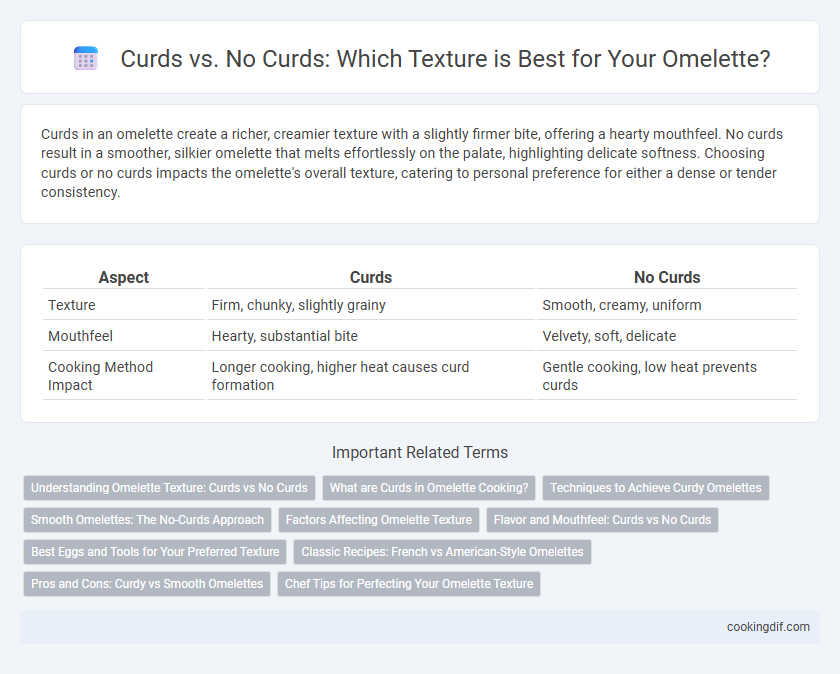Curds in an omelette create a richer, creamier texture with a slightly firmer bite, offering a hearty mouthfeel. No curds result in a smoother, silkier omelette that melts effortlessly on the palate, highlighting delicate softness. Choosing curds or no curds impacts the omelette's overall texture, catering to personal preference for either a dense or tender consistency.
Table of Comparison
| Aspect | Curds | No Curds |
|---|---|---|
| Texture | Firm, chunky, slightly grainy | Smooth, creamy, uniform |
| Mouthfeel | Hearty, substantial bite | Velvety, soft, delicate |
| Cooking Method Impact | Longer cooking, higher heat causes curd formation | Gentle cooking, low heat prevents curds |
Understanding Omelette Texture: Curds vs No Curds
Omelette texture varies significantly depending on the presence of curds, which are formed when proteins coagulate during cooking, creating a firmer and denser structure. Smooth, no-curd omelettes tend to be creamy and tender, achieved by gently folding beaten eggs and cooking over low heat to prevent protein clumping. Mastering the balance between curd formation and softness enhances the mouthfeel and overall quality of the omelette.
What are Curds in Omelette Cooking?
Curds in omelette cooking are the coagulated protein clusters that form when eggs are heated, creating a thicker, denser texture. The presence of curds results in a creamy and tender omelette, while avoiding curds produces a smoother, more custard-like consistency. Achieving the ideal balance of curds depends on precise temperature control and cooking technique to enhance texture and flavor.
Techniques to Achieve Curdy Omelettes
Creating a curdy omelette requires careful control of heat and stirring techniques to encourage the formation of distinct, soft curds rather than a smooth, uniform texture. Cooking the eggs over medium-low heat while gently stirring allows the proteins to coagulate gradually, producing a rich, tender curd structure. Avoiding high heat prevents overcooking and rubbery textures, ensuring the omelette retains a delicate, creamy consistency characteristic of a curdy finish.
Smooth Omelettes: The No-Curds Approach
Smooth omelettes achieve their silky texture by avoiding curds, which are formed when eggs coagulate unevenly at high heat. Cooking eggs gently over low to medium heat while continuously stirring or folding prevents curd formation, resulting in a creamy, custard-like consistency. This no-curds method emphasizes precise temperature control and gentle handling to maximize smoothness and tenderness in every bite.
Factors Affecting Omelette Texture
Curds in an omelette result from the coagulation of egg proteins due to high heat, leading to a denser, slightly grainy texture, while no curds yield a smoother, creamier consistency. Factors affecting omelette texture include cooking temperature, whisking method, and the addition of milk or cream, which influence protein coagulation and moisture retention. Precise control over heat and gentle cooking techniques prevent curd formation, ensuring a tender, soft omelette.
Flavor and Mouthfeel: Curds vs No Curds
Curds in an omelette create a creamy, rich texture that enhances the mouthfeel, providing a velvety and satisfying bite. Without curds, the omelette has a smoother, more homogeneous texture, emphasizing a delicate flavor profile without the contrasting creaminess. Choosing curds intensifies the overall sensory experience, balancing robust taste with a luscious, tender consistency.
Best Eggs and Tools for Your Preferred Texture
Selecting the best eggs, preferably fresh and high-quality free-range or organic eggs, enhances the texture of your omelette whether you prefer curds or a smooth finish. Use non-stick pans and silicone spatulas for gentle folding that preserves delicate curds or creates a creamy, custard-like consistency without curdling. Temperature control is crucial; low to medium heat helps achieve tender curds, while slightly higher heat with vigorous stirring prevents curd formation for a silky texture.
Classic Recipes: French vs American-Style Omelettes
French-style omelettes achieve a smooth, custard-like texture by gently cooking eggs without forming curds, resulting in a tender and silky finish. American-style omelettes feature distinct, soft curds created by slightly higher heat and more vigorous stirring, producing a firmer and fluffier texture. Understanding these textural differences is essential for mastering classic omelette techniques and achieving authentic flavor profiles.
Pros and Cons: Curdy vs Smooth Omelettes
Curdy omelettes have a slightly granular texture due to overcooked or vigorously stirred eggs, which can offer a rustic and hearty mouthfeel but may be perceived as dry and less tender. Smooth omelettes yield a creamy, silky texture achieved by gentle cooking and minimal stirring, enhancing moisture retention and yielding a soft bite preferred for delicate fillings. Choosing between curdy and smooth textures depends on personal taste preferences and the desired mouthfeel, with smooth omelettes excel at elegance and moisture, while curdy variations provide a firmer, satisfying chew.
Chef Tips for Perfecting Your Omelette Texture
Achieving a smooth omelette texture requires careful heat control to prevent curd formation, as overcooking causes protein to coagulate unevenly. Whisking eggs thoroughly with a splash of milk or water enhances uniformity and tenderness by promoting even cooking. Using a non-stick pan and gently stirring during cooking helps maintain a creamy, curd-free consistency essential for a flawless omelette.
Curds vs No Curds for texture Infographic

 cookingdif.com
cookingdif.com